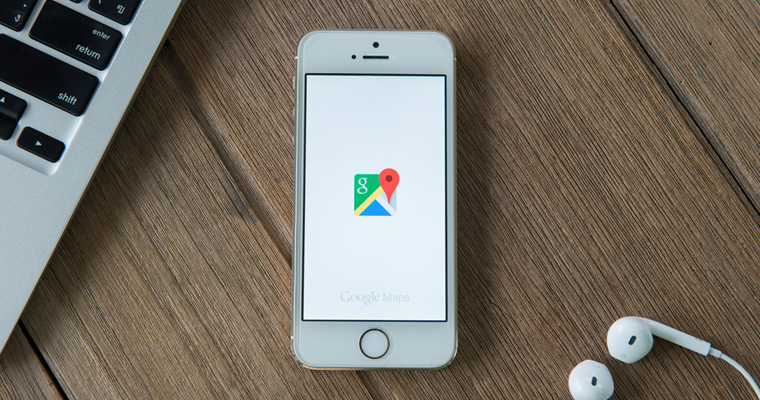As an SEO enthusiast, I’m always looking for ways to shake up my routine for my local clients — namely, to make it quicker, easier, and less of a pain in the you-know-what for them to rank in Google local search. And sometimes, now and then, Google delivers a perfectly packaged gift wrapped in a quirky, multicolored bow right to my inbox. Yes, I’m talking about the recent update Google made to Google My Business help page.
While most of us SEOs could probably optimize Google local listings in our sleep (no? just me?), verifying locations — and all the custom-tailored customer service, profile management, and brand-to-consumer conversations — is an entirely different story. So with your precious time and this new ranking signal for local SEO in mind, I’m rewriting the rules on how to rank in Google local search.
And, with 50% of consumers who conducted a local search on their smartphone visiting a store within a day, you’re going to want to pay attention, very carefully. Psst…this means your local SEO strategy can have a direct impact on in-store traffic.
(Warning: You may find yourself tossing out your 2013 Google Places strategy and switching up your post-Pigeon tactics.) Feels good to rebel, doesn’t it?
Need to start from the beginning? Check out this guide to local SEO strategy for beginners.
How Does Google Rank Your Local Business in Local Search?
Mere months ago, if you’d asked me to reach for my most top performing local SEO tactic, I might’ve whipped out some keyword research or created a super-unique local URL structure. But, today, I’m well acquainted (and entirely infatuated) with how Google determines local rankings: relevance, distance, and — yep, you guessed it, prominence.
So, imagine my delight in discovering I could embrace my newfound love of Google’s ranking signals in a fresh way by integrating brand awareness. Sound like another Google algorithm update that may be a waste of your time? Not so. With the vague introduction of Google Pigeon in 2014, the local search community has been preparing for the crosslinking between “traditional web signals” and local search over a year now.
Check out below how Google ranks your local business in local search based on the recent update:
Relevance
Relevance refers to how well a local listing matches what someone is searching for. Adding complete and detailed business information can help Google better understand your business and match your listing to relevant searches.
Distance
Just like it sounds–how far is each potential search result from the location term used in a search? If a user doesn’t specify a location in their search, Google will calculate distance based on what’s known about their location.
Prominence
Prominence refers to how well-known a business is. Some places are more prominent in the offline world, and search results try to reflect this in local ranking. For example, famous museums, landmark hotels, or well-known store brands that are familiar to many people are also likely to be prominent in local search results.
Prominence is also based on information that Google has about a business from across the web (like links, articles, and directories). Google review count and score are factored into local search ranking: more reviews and positive ratings will probably improve a business’s local ranking. Your position in web results is also a factor, so SEO best practices also apply to local search optimization.
So, let’s break this down even further:
Relevance
Ask yourself: Does the search query the person typed into the Google search bar match your local listing?
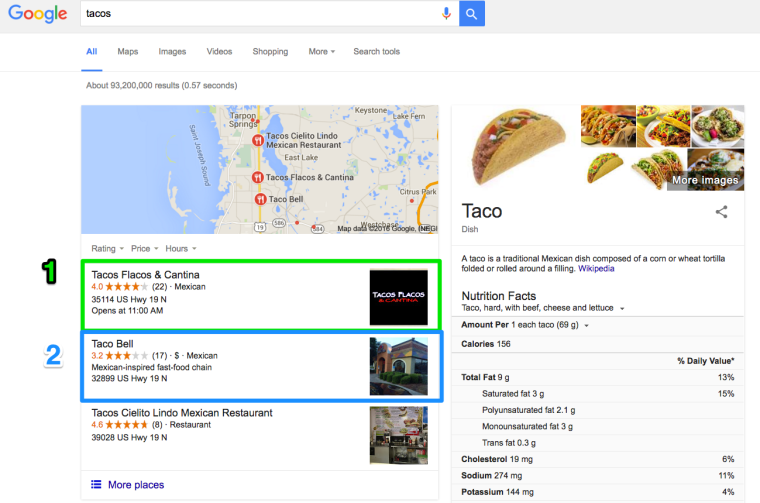
Take a look at this search “tacos.” Tacos Flacos & Cantina is above Taco Bell (even though Taco Bell is closer in physical location) in the local search results because Google believes the Tacos Flacos & Cantina local listing is more relevant to my search “tacos”.
This is why it’s so important to know who your audience is and monitor your keyword buckets. If your local listing is optimized for keyword queries your target audience searches for, then you should show up in the SERPs.
Distance
What is the physical distance between your local listing and the search query? For example, if I type in “coffee” the local search results give me the closest coffee shop first.
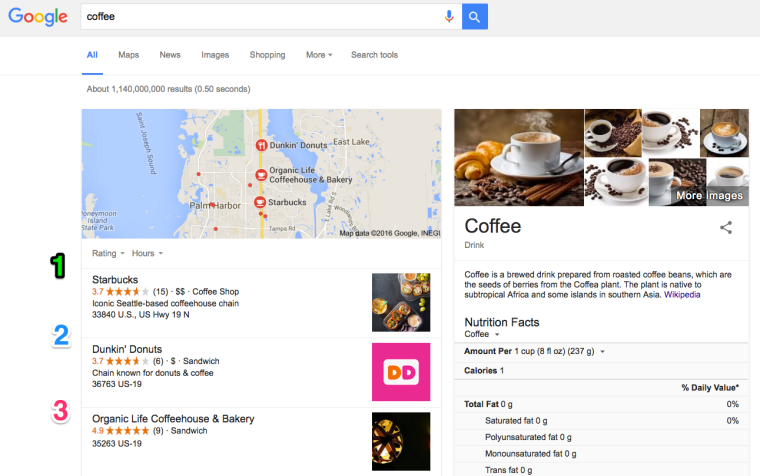
As we have seen from the previous search above, Google will rank a more relevant local listing higher in the search results than if a business is closer to a searcher’s location.
Prominence
How popular is your business? Google pulls information from across the web (directories, articles, links, etc.) including your reviews and position in the search results to help position you in local search. So essentially, the more link building, the more positive customer reviews, and the better overall organic ranking your business has, the better local positioning your business will have.
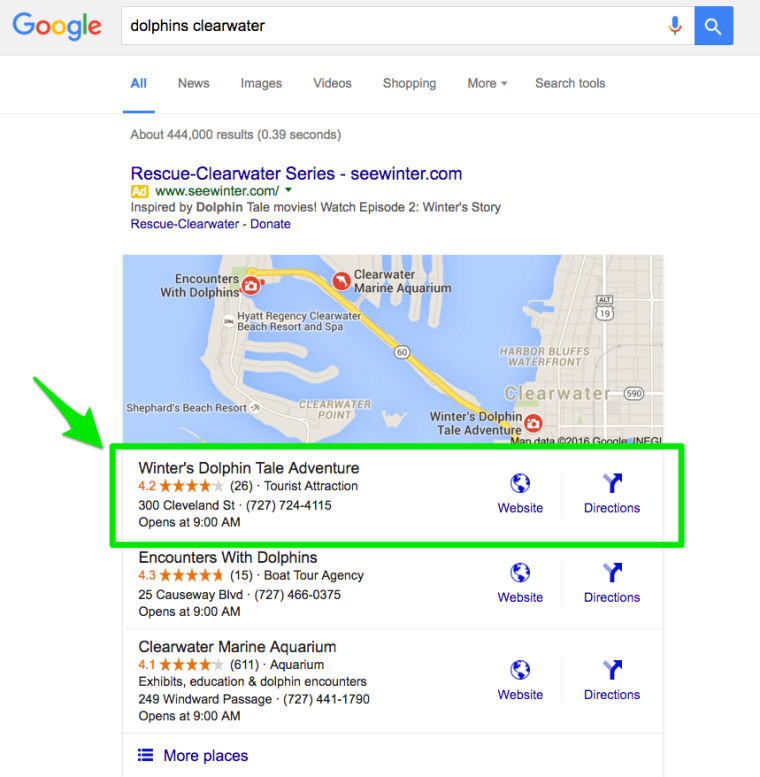
So, for example, if you’re visiting Clearwater, Florida for a summer vacation, you might want to swim with the dolphins. But, your search results pop up with Winter’s Dolphin Tale Adventure because this is from the famous Disney movie, Winter. Google will show searchers places they are familiar with in an effort to display more relevant search results.
How Has Local Search Evolved?
The 2000s were genuinely strange years for local SEO. For the early half of the decade, it felt like Google was perpetually in amelioration; Google was just kind of wandering around, playing with Google Maps, launching 3-Packs, 7-Packs, 10-Packs, wondering if their Google “Plus Box” and the local business center would stand the test of time. And though times have certainly changed since, there’s nothing more fun than taking a trip down memory lane. Below, I take a look at some of the most iconic local SEO moments.
2005: The birth of Google Maps.
2007: Google begins listing local business information in search results.
2008: The Local OneBox moves up from display only 3 local businesses to 10.
2009: The 7-Pack becomes the 10-Pack.
2010: Google’s Local Business Center becomes Google Place Pages.
2012: Google launches Venice and ShieldsUp updates. Google+ Local takes the place of Google Places. Finally, we see Google+ Business and Google+ Local merge.
2014: Google creates Google My Business. And, we meet Pigeon, perhaps the biggest local search algorithm update.
If you had a local business in the early 2000s, the number one local SEO tactic on your list was getting listed Google’s OneBox display. Then, later it became the 10-Pack.
Perhaps the most strategy-changing update Google has made to improve localized SEO is the launch of Pigeon. On July 24, 2014, Pigeon was rolled out to influence distance (that second ranking signal I discussed above). It appeared that directories like Yelp were being favored above local businesses.
But, as you can see by the search queries below in an analysis by BrightEdge, many local businesses benefited from Pigeon while others took a hit:
- Hospitality (+28%)
- Food (+19%)
- Education (+13%)
- Jobs (-68%)
- Real Estate (-63%)
- Movie (-36%)
- Insurance (-11%)
Also, following the Pigeon update, Moz updated their report for the Local Search Ranking Factors 2014 which has since changed in 2015.
Take a look at the 2014 top 10 localized ranking factors, according to Moz:
- City, State in Landing Page title
- Domain Authority of Website
- Page Authority of Landing Page URL
- Quality/Authority of Inbound Links to Domain
- Quality/ Authority of Inbound Links to Landing Page URL
- Physical Address in City of Search
- Quality/Authority of Structured Citations
- Product / Service Keyword in Website URL
- Click-Through Rate from Search Results
- City, State in Landing Page H1/H2 Tags
Now, compare 2014 top 10 localized ranking rankings to 2015, according to Moz:
- Domain Authority of Website
- Quality/Authority of Inbound Links to Domain
- City, State in GMB Landing Page Title
- Click-Through Rate from Search Results
- Topical (Product/Service) Keyword Relevance of Domain Content
- Diversity of Inbound Links to Domain
- Geographic (City/Neighborhood) Keyword Relevance of Domain Content
- Physical Address in City of Search
- Quality/Authority of Structured Citations
- City, State in Most/All Website Title Tags
Mobile + Local = PB&J
Google’s Pigeon algorithm is structured to deliver more accurate and relevant local search results that are linked to traditional ranking signals.
With Pigeon also came the increase of mobile search queries. According to a study by Google, the percentage of mobile searches with local intent is 50%.
According to Google’s Smartphone study:
- 4 in 5 consumers use search engines to find local information.
- Local searches lead to more purchases than non-local searches. 18% of local searches on smartphone lead to a purchase within a day vs. 7% of non-local searches.
- 30% of consumers would buy in-store instead of online knowing they are close to a store.
- 57% of smartphone users look for local info at least once a week
So why is mobile in important for local?
A research study by BrightLocal found that 50% of mobile users prefer using a mobile browser to a mobile app. So, having a mobile-friendly site, AMP-optimized pages, and engaging content (especially with Google Posts), allows users to engage with you without visiting your site. You want to prepare users with as much consistent and accurate information about your brand as you can before they interact with your website. It’s essential to dedicate time to creating AMP pages, Google Posts, and any other new mobile tricks Google comes up because this is what Google will display first in the mobile local search results, no matter how optimized your mobile-friendly website is.
The mobile SERP has users scrolling a significant amount just to reach non-Google-Local listings (first one highlighted in green) compared to the desktop.
Now, today, SEOs are met yet again with the new feat of tackling the “prominence” ranking signal. Good news is, you don’t have to turn to spammy tactics or blast your business name in 100+ local directories. Instead, I’m taking Google’s new ranking signal and pairing it with tried and true local SEO strategies that you can trust. I’ve never been one to blend in with the crowd, especially with my local search results, and with these tips ahead you won’t be, either.
How to Rank Your Local Business in Google Local Search Results
“I love managing my local listings!” said no one ever. It’s surprisingly hard to edit all your current live local listings, and you usually end up with a mess of listings with the wrong business name, address, logo, or someone by the name of Rob (whom you’ve never heard of) magically became the CEO according to this spammy site, LinkVerve.
If you hate managing your local listings but don’t want to go give up on ranking your local business, I’ve got a few tricks for you — hassle and random-Rob-free, of course. Just a few basic SEO tactics and presto, your local business is ranking and perfectly targeted to your audience. Let’s get started.
On-Site Optimization for Local SEO
If there’s one misconception that deserves to be locked away for good, it’s that if you’ve already optimized your site for SEO, you don’t need to worry about it for local SEO. Simply put: Much like any other SEO tactic, you do need to go back and optimize for local SEO. According to Moz from the survey above, optimizing your on-page SEO could count for 20% of what Google determines to serve up to its local searchers.
Ahead, learn how to create a website that will change your local SEO game one click at a time.
Create a Mobile-Friendly Site
Cision stated 72% of smartphone use occurs during consumer travel, and other research tells us most consumers are searching for a location within five miles of their starting point. So basically I can conclude that the majority of visitors are using their mobile to access information about local businesses. Sound about right?
We all know since Mobilegeddon that the Google algorithm considers mobile readiness as a ranking signal in the search results; and with the recent introduction of AMP, which affects site speed, both local and search are continuing to change the user’s website experience.
Add Local Keyword Terms to Tags (Title Tag, H1, H2, Image Alt Tags)
Keywords are a must — and not just for the SEO wannabes and account strategist out there. For the local businesses and DIYers using tools like Ubersuggest, Google Autocomplete, and Google Suggest, and of course, Google Keyword Planner, to craft their content just like many of us agency life 9-to-5ers, you need to make sure you’re coupling your top keyword search terms with your geographic location.
A good example of this is a Tampa-based tea boutique called TeBella Tea Company. Have a look at the image below to see what I mean:
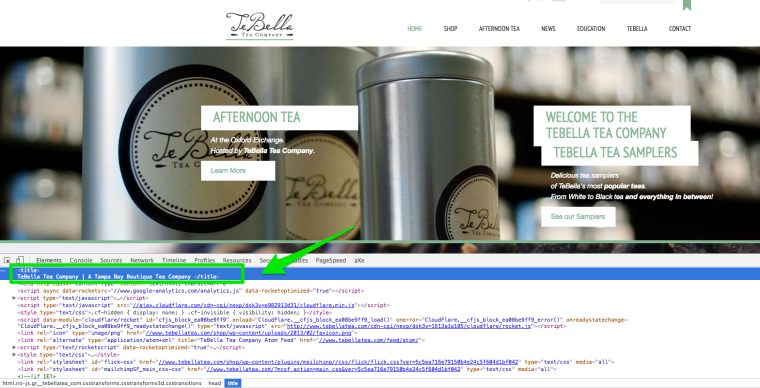
TeBella has the geographic location in the meta title.
If you’re feeling confident about your tags, try embedding a Google map with your business marker to your contact page.
Here’s an example from a client of mine, YogaBrights:
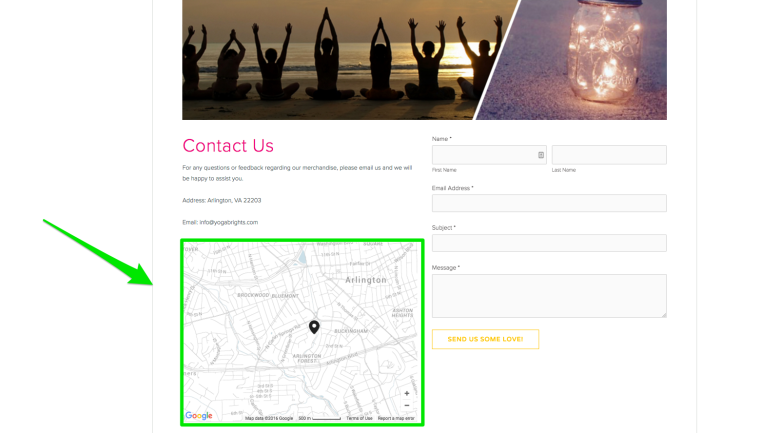 Insert Your NAP into Your HTML
Insert Your NAP into Your HTML
I can’t say it enough: Adding your NAP into your HTML is no joke — and inconsistency in your name, address, and phone number from your website to your citations is just as bad. Quality, quantity, and consistency are all critical. Personally, I like to put my NAP into my footer because this is where consumers expect to see it.
A 2013 survey of 350 SMBs by ConstantContact found that 49% of businesses never update their name listings online. Inside Local discovered mismatched NAP’s accounted for 41% of the total ranking issues.
Most of us use our citations the same way we did when 10 years ago — build 50+ citations, add a “st.” here and a “street” address there, maybe (ideally) a brief description, then we’re out the door and onto the next one. If it ain’t broke, why fix it, right? Wrong. Oh, so wrong. You see, there’s actually some serious SEO benefit to making sure your citations are consistent and read exactly as listed on your website.
Here’s an example of inconsistency from Bandit Coffee Co. in Tampa.
The brand name on the website is Bandit Coffee Co. on their website:
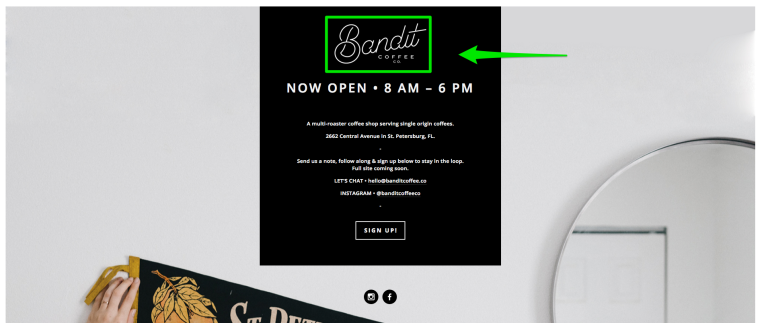
But, on Yelp, Bandit Coffee Co. reads “Bandit Coffee.” Yes, it’s minor, but updating this minor name mishap can help the search engines connect the dots.
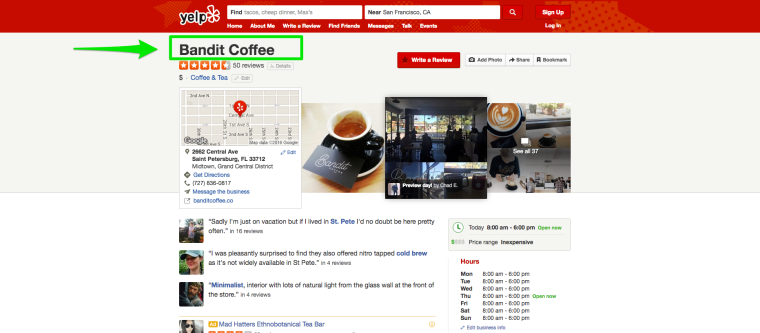
It’s also vital that your phone number is high visible on your website and clickable on your mobile site.
Also, having a contact page or a store locations for each of your locations with the name, address, and phone number of each of your locations doesn’t hurt either. Take a look at Kahwa Coffee:
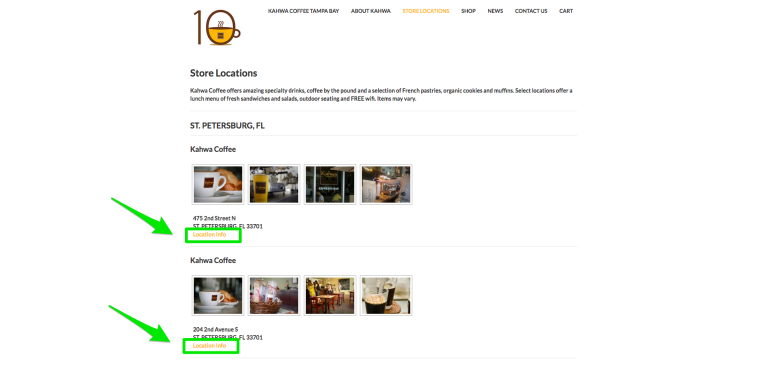
Kahwa Coffee has each of these pages with separate landing pages and unique content that caters to these localized audiences. This makes these location-specific pages easy for search engines to discover. You can go one step further and optimize the title tags and submit them through the XML sitemap. It also helps that Kahwa Coffee has their locations listed from the high-level main navigation.
Lastly, if you have multiple locations, place their name, address, and phone number in the sitewide footer (if under 10).
Write Local-Focused Content
There are many things quality content is known as being good for — like increasing pageviews, boosting social shares, and an uptick of pretty awesome organic traffic. One thing it’s not known for? Fostering local SEO. Well, according to Brian Dean, there are 164 million blogs online (I swear I’m not making that up), and most of us are missing out on how to capitalize on our blogs.
Here’re some tips to make sure you’re getting the most out of your blog for local SEO:
- Identify what neighborhoods you want to reach, and who makes up those neighborhoods. What are they searching for? How can you help them?
- Use tools like Google Trends, Google Keyword Planner, and Facebook Insights to determine the demand for your product or service within your local neighborhoods. You can also use this to search for demographic information and interest categories.
- Write about local events, festivals, attractions or even your favorite little eatery (like these guys). Think about anything that searchers would “google” when searching your city.
- Interview your customers about how you made their day with your product or service.
- Craft local-focused meta titles and descriptions for each locally-driven blog post. This includes your image alt attributions also.
Here’s a great example of local-focused content in a blog:
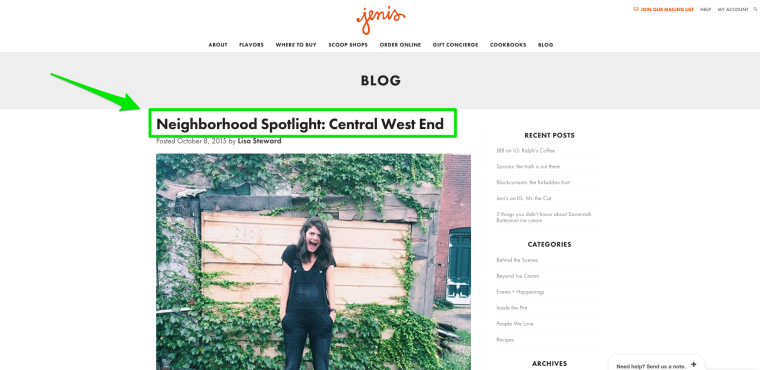
Remember to monitor your content’s performance for your local strategy. To do this, track your local keyword terms that are coupled with the content (or blog posts) you’re pushing out. Match these with the goals you’re looking to achieve. For example, are you trying to rank for local searches? Do you want more organic sale conversions from your neighborhood? You know the fun stuff like that.
Create Schema MarkUp for Each Location
It’s not news that SEOs are embracing more technical roles, with the words schema, structured data, and < /div> gaining momentum and significance. Many local businesses and SEOs, when considering the importance of local SEO, examine their schema markup first. Using the schema markup, you can tell the search engines your physical street address as well as your latitude and longitude.
Let’s walk through how to set-up your schema markup language:
- Head over to http://schema-creator.org/organization.php.
- Fill in the data and copy/paste the code under the preview section onto your website.
- You may need to take out the line breaks between the city, state, ZIP code, and country before pasting the code in depending on what platform you’re using.
- Add your phone number to the bottom of the code like this:
</div>
Phone: <span itemprop=”telephone”>1234567890</span>
</div>
5. Add your longitude and latitude underneath the phone number.
itemscope itemtype=”http://schema.org/GeoCoordinates”>
<span itemprop=”latitude”> 12.3456 N </span>
<span itemprop=”longitude”> 12.3456 W </span>
</div>
6. Once the code is added to your site, test it with the Google’s Structured Data Validation tool.
In the end, you should have something that looks like this:
itemscope itemtype=”http://schema.org/LocalBusiness”>
<p itemprop=”name”>BUSINESS NAME</p>
itemtype=”http://schema.org/PostalAddress”>
<p itemprop=”streetAddress”>ADDRESS LINE 1</p>
<p itemprop=”addressLocality”>CITY</p>,
<p itemprop=”addressRegion”>REGION</p>
<p itemprop=”postalCode”>POSTCODE/ZIP</p.
<p itemprop=”telephone”>PHONE NUMBER</p>
<meta itemprop=”latitude” content=”LATITUDE” />
<meta itemprop=”longitude” content=”LONGITUDE” />
</div>
Citations
As we saw above in the Moz ranking factors comparison from 2014 to 2015, the SEO industry is beginning to see the focus shift from on-page optimization to the importance of high-quality links. And, according to BrightLocal, 55% of experts say citations are ‘critical’ to local search ranking.
Creating citations used to be super time-consuming, but the act of getting listed doesn’t have to be. The secret? Focus on a handful of citations that are relevant to your brand and industry AND links from local websites (whether they are considered high-quality or not). If local SEO is your main gig, then pushing to get links on local websites where the Domain Authority or social following is a little lower than the average site you would target is totally acceptable.
Of course, it’s no secret that there are a lot of not-so-high-quality citation tactics out there. So, I’ve sorted through the selection and picked the best of the best. Below, you’ll find SEJ-approved options for every local SEO budget, from manual link building to smancy tools that will instantly speed up local SEO domination.
- Sign-up for Mention, Google Alerts, and set-up IFTTT to track mentions of your competitor’s new listings and your mentions.
Success story: A local hotel who is a client of mine was mentioned on a local news site publishing content about Orlando hotels here. Upon publishing, there were no links included at all. I sought out the publisher and was successful in getting a link added to the website URL at the bottom.
2. Depending on your category, cross-check your local listing with Moz’s Best Local Citations by Category to be sure you’re featured in the top directories. If you’re not listed, manually add your business.
3. If you have an account with Ahrehs, Open Site Explorer, or Majestic, you can run a competitive link report to pull the citations your competitors have already obtained.
4. Utilize your blog to create a local resource. Airbnb is a good example of how to do this with their neighborhood guides.
5. Create a local community event or go to a Meetup.com
6. Offer discounts or free products/services to local organizations.
If you’re into networking and growing your business— or even if you aren’t — these few simple local SEO link building strategies make for a Yelp-I-want-to-compete-for-the-top-local-stop vibe.Translation: Your local business will be gain brand awareness and SEO value.
As I mentioned above, cross-checking your NAP to your citations is essential. For example, type “your local business name” + “BBB” into the Google search box. The Better Business Bureau will give you a list of alternate business names, addresses, and phone numbers that you will want to have updated.
Google My Business
One of the first things I do when I first get a new client (after stalking them for the fifth and final time) is sign them up for a Google My Business account. It’s the backbone of any good local SEO strategy, along with content and descriptions. No matter what industry you’re in, Google My Business still matters. Updating and optimizing your page to be consistent can make or break your local SEO.
These are the sections you can update on Google My Business. Note: These should be consistent across all your citations.
- Business Name: Add your business name (no keywords) as it is seen on your website.
- Address: Again, this should read exactly as it does on your website.
- Phone Number: I would suggest using your local number if you have one.
- Website URL: This allows you to verify that you are the site owner.
- Category: The first category you choose will be the main category of your business. You can add up to ten categories but the first category you choose is the most important. Here’s an example of the category options:
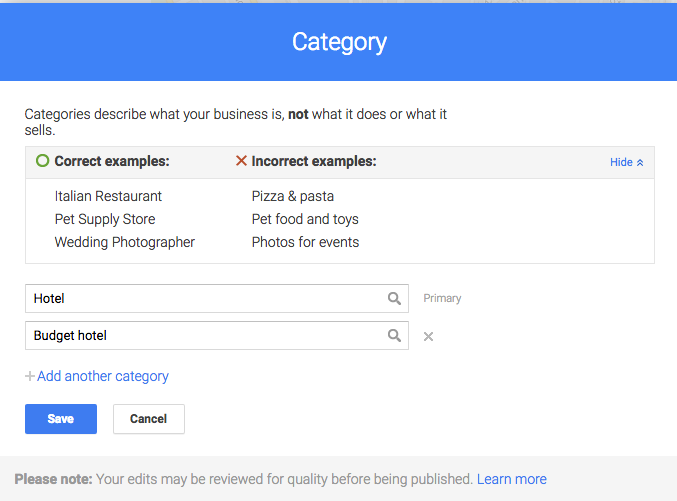
- Hours: This section is extremely helpful for mobile searches. Plus, Google announced you can set specific hours in the card view.
- Introduction: Here you have 4,000 characters to play with. This is where you want searchers to understand what your business does.
- Photos: Always add a profile and a logo picture. You can also select the pictures that can be shown in Google Maps and as a Google+ Cover.
When creating your Google My Business account always use your domain email address. It adds credibility to your Google My Business account as well as your other listings.
Local businesses now have a new way to compete in the SERPs with Local Business Cards from Google Posts. This is a new test that allows businesses to post content directly into Google’s search results that look like scrollable cards.
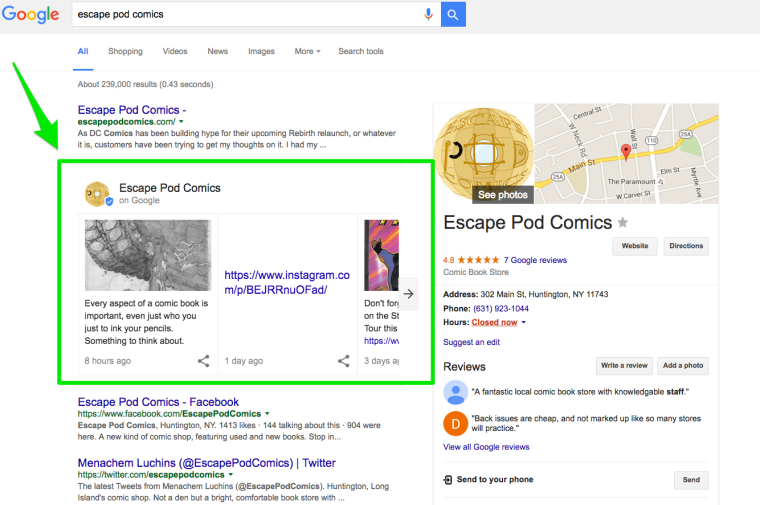
Customer Reviews
Is there any feeling quite so confidence-boosting as knowing you made a customer happy? You breeze through your positive customer reviews on Yelp, or a customer sends you an email bragging about their recent dine-in experience, and you just know they’re thinking, “Wow. This company has got it together.”
The blatant proclamation: Positive customer reviews are fantastic. Any positive action that a customer takes to make your business sound ah-mazing is alright in my book. If you get could one on a daily basis, I’d recommend it.
A survey conducted by Dimensional Research found that 90% of their respondents claimed that positive online reviews influenced their buying decisions while 86% had responded saying that negative reviews impacted their decisions.
Plus, review signals can help you rank better Google’s local algorithm and now that you no longer need a Google+ account to write reviews on Google, I expect to see the impact of these reviews continue to increase. Even Moz previously found that review signals count for 8.4% of the ‘local ranking pie.’
Believe it or not, reviews are typically the first interview local searchers will see on their desktops, mobiles, or tablets. Think Yelp, Google My Business, UrbanSpoon, TripAdvisor. Consumers browse through these reviews looking for the positive and not-so-positive. Managing these reviews regularly is super important not only for SEO purposes but for consumer experience.
Below, some tips you need to make your reviews more friendly and less stressful.
- Always act natural and make every response unique to each customer.
- Respond to reviews within 24 to 48 hours. Personally, I keep track of all requests on a spreadsheet for later review.
- Take a deep breath and respond to negative reviews in a calm, respectful manner. Don’t delete them unless they are outside of your brand guidelines. HelpScout offers some great advice on how to deal with angry customers.
You should let customers know where they can post reviews. Most consumers don’t know where you’re listed or even how to leave a review so guide them through this process. Try these simple tips:
- Get your business listed on the main directories: Google+ Local, Yelp, Foursquare, Citysearch, YP.com.
- Use this super helpful “Review Handout Generator” by Whitespark and Phil Rozek that walks you through to get reviews on Google.
- Add your review profiles to your website. Here’s an example from Tribeca Salon.
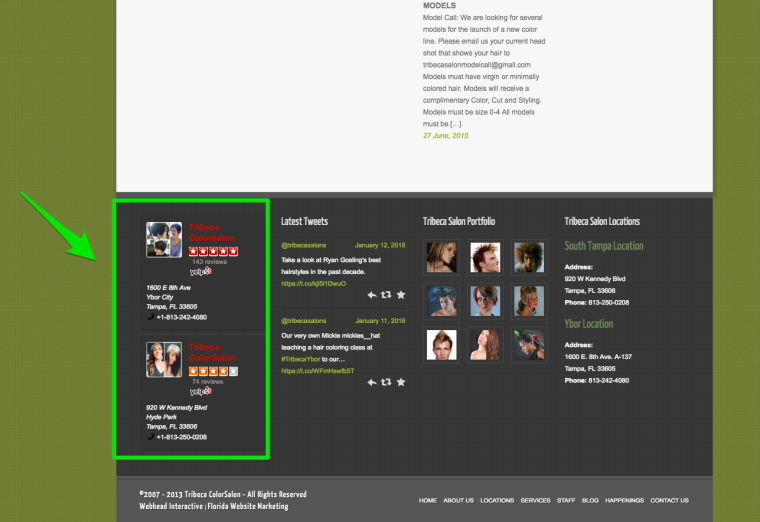
- Request a “Find Us on Yelp,” sticker.
- Write a custom email campaign asking customers to write a review. Check out this example from Fig & Flower.
In addition to getting reviews in the main listing sites, maintain your social media reputation is an awesome way to boost local SEO. Sites like YouTube and Twitter can help with local content.
Conclusion
With Amazon Echo integrating with Yelp and testing review snippets in local 3-packs, we’re going to continue to see local SEO evolve. Continuing to monitor your brand and keyword targets at a local level will help you determine your geo-targeted market and help you create future localized campaigns. With ‘prominence’ coming into the ranking mix, link signals and brand mentions are going to continue to grow in strength.
Continuing to do a monthly or bimonthly audit of your local SEO will help you map out what needs to be done and where you should start your strategy. Andrew Shortland put together this excel template that I recommend you check out to help guide your local SEO strategy.
Image Credits
Featured Image: RAYBON/Shutterstock.com
All screenshots by Anna Crowe. Taken April 2016.

